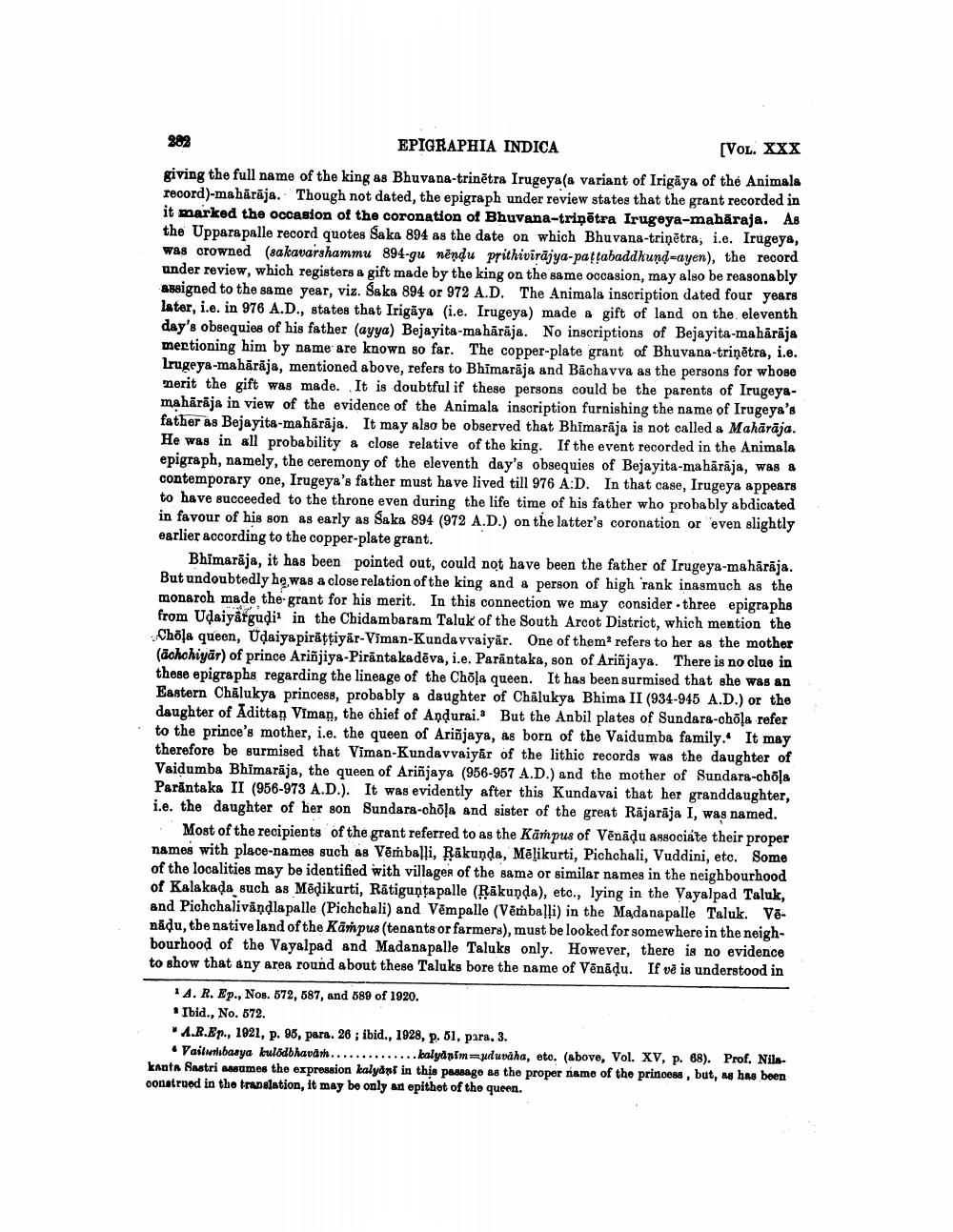________________
282 EPIGRAPHIA INDICA
[Vol. XXX giving the full name of the king as Bhuvana-trinētra Irugeya(a variant of Irigāya of the Animala record)-mahārāja. Though not dated, the epigraph under review states that the grant recorded in it marked the occasion of the coronation of Bhuvana-triņātra Irugeya-mahāraja. As the Uppara palle record quotes Saka 894 as the date on which Bhuvana-trinētra, i.e. Irugeya, was crowned (sakavarshammu 894-gu nêndu prithivirajya-pattabaddhund=ayen), the record under review, which registers a gift made by the king on the same occasion, may also be reasonably assigned to the same year, viz. Saka 894 or 972 A.D. The Animala inscription dated four years later, i.e. in 976 A.D., states that Irigaya (i.e. Irugeya) made a gift of land on the eleventh day's obsequios of his father (ayya) Bejayita-mahārāja. No inscriptions of Bejayita-mahārāja mertioning him by name are known so far. The copper-plate grant of Bhuvana-triņētra, i.e. Irugeya-mahārāja, mentioned above, refers to Bhimarāja and Bachavva as the persons for whose merit the gift was made. It is doubtful if these persons could be the parents of Irugeyamahārāja in view of the evidence of the Animals inscription furnishing the name of Irugega's father as Bejayita-mahārāja. It may also be observed that Bhimarāja is not called a Mahārāja. He was in all probability & close relative of the king. If the event recorded in the Animala epigraph, namely, the ceremony of the eleventh day's obsequies of Bejayita-mahārāja, was a contemporary one, Irugeya's father must have lived till 976 A:D. In that case, Irugeya appears to have succeeded to the throne even during the life time of his father who probably abdicated in favour of his son as early as Saka 894 (972 A.D.) on the latter's coronation or even slightly earlier according to the copper-plate grant.
Bhimarāja, it has been pointed out, could not have been the father of Irugeya-mahārāja. But undoubtedly he was a close relation of the king and a person of high rank inasmuch as the monarch made the grant for his merit. In this connection we may consider three epigraphs from Udaiyârgudit in the Chidambaram Taluk of the South Arcot District, which mention the Chola queen, Udaiyapirättiyår Vsman-Kunda vvaiyar. One of them refers to her as the mother (achchiyār) of Prince Ariñjiya-Pirantakadēva, i.e. Parantaka, son of Ariñjaya. There is no clue in these epigraphs regarding the lineage of the Chola queen. It has been surmised that she was an Eastern Chalukya princess, probably a daughter of Chalukya Bhima II (934-945 A.D.) or the daughter of Adittan Viman, the chief of Andurai. But the Anbil plates of Sundara-chōļa refer to the prince's mother, i.e. the queen of Ariñjays, as born of the Vaidumba family. It may therefore be surmised that Viman-Kundevvaiyār of the lithic records was the daughter of Vaidumba Bhimarāja, the queen of Ariñjaya (956-957 A.D.) and the mother of Sundara-chola Parāntaka II (956-973 A.D.). It was evidently after this Kundavai that her granddaughter, i.e. the daughter of her son Sundara-chõļa and sister of the great Rājarāja I, was named.
Most of the recipients of the grant referred to as the Kāṁpus of Vēnādu associáte their proper names with place-names such as Vēmballi, Rākunda, Mēļikurti, Pichchali, Vuddini, etc. Some of the localities may be identified with villages of the same or similar names in the neighbourhood of Kalakada such as Mēdikurti, Rātiguņtapalle (Rākunda), etc., lying in the Vayalpad Taluk, and Pichchalivāndlapalle (Pichchali) and Vēm palle (Vērballi) in the Madanapalle Taluk. Vēnādu, the native land of the Kampus (tenants or farmers), must be looked for somewhere in the neighbourhood of the Vayalpad and Madanapalle Taluks only. However, there is no evidence to show that any area round about these Taluks bore the name of Vēnādu. If ve is understood in
* A. R. Ep., Nos. 572, 687, and 180 of 1920. * Ibid., No. 572.
4.R.Er., 1921, p. 86, para. 26 ; ibid., 1928, p. 61, para. 3.
• Vaitubasya kulodbhavan. ............. kalyanim=uluväha, eto. (above, Vol. XV, p. 88). Prof. Nilakanta Sastri assumes the expression kalyant in this passage as the proper name of the princess, but, as has been construed in the translation, it may be only an epithet of the queen.




